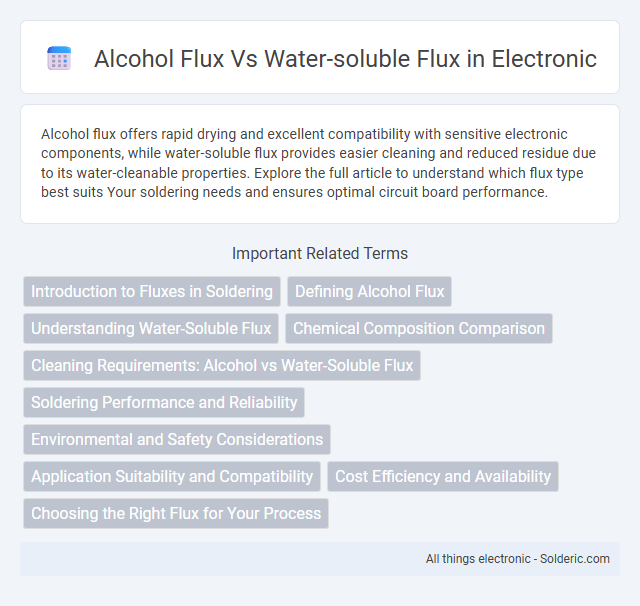Alcohol flux offers rapid drying and excellent compatibility with sensitive electronic components, while water-soluble flux provides easier cleaning and reduced residue due to its water-cleanable properties. Explore the full article to understand which flux type best suits Your soldering needs and ensures optimal circuit board performance.
Comparison Table
| Feature | Alcohol Flux | Water-Soluble Flux |
|---|---|---|
| Composition | Alcohol-based solvents with active rosin or organic components | Water-based solvents with organic acids or additives |
| Cleaning Method | Requires alcohol or solvent cleaning | Easily cleaned with water |
| Residue | Typically leaves minimal residue, may be slightly sticky | Leaves residue that is easily removable by water |
| Corrosion Risk | Low to moderate, depends on formulation | Higher if not cleaned properly due to acidic residues |
| Application | Used for delicate electronics, precision soldering | Common in general assembly and repair work |
| Environmental Impact | Contains volatile organic compounds (VOCs) | Lower VOC emissions, eco-friendlier |
| Flux Activation Temperature | Typically 130-180degC | Typically 140-220degC |
| Cost | Moderate to high | Generally low to moderate |
Introduction to Fluxes in Soldering
Alcohol flux and water-soluble flux serve as essential agents in soldering, facilitating the removal of oxides and improving metal bonding. Alcohol flux typically evaporates quickly and leaves minimal residue, making it suitable for delicate electronics requiring clean joints. Water-soluble flux offers strong cleaning action with residues that can be easily washed away with water, enhancing post-soldering maintenance and reliability in circuit boards.
Defining Alcohol Flux
Alcohol flux is a type of soldering flux primarily composed of alcohol solvents that effectively remove oxides and contaminants from metal surfaces during soldering. Unlike water-soluble flux, which requires thorough cleaning due to its corrosive residues, alcohol flux tends to evaporate cleanly, leaving minimal residue and reducing post-soldering cleaning efforts. Choosing alcohol flux can enhance the precision and longevity of your electronic components by providing reliable oxidation removal without the risk of residue-related damage.
Understanding Water-Soluble Flux
Water-soluble flux is designed to dissolve in water, enabling easy post-soldering cleaning and reducing residue on circuit boards, which enhances reliability and performance. Unlike alcohol flux, water-soluble flux contains activated compounds that promote effective solder joint formation while minimizing corrosion and improving electrical conductivity. You can achieve cleaner assemblies and lower environmental impact by choosing water-soluble flux for your soldering processes.
Chemical Composition Comparison
Alcohol flux primarily contains organic solvents such as isopropanol or ethanol combined with rosin or synthetic resins, promoting effective solder wetting and residue removal through rapid evaporation. Water-soluble flux features organic acids like citric acid or fumaric acid along with surfactants, allowing complete rinsing with water to eliminate flux residues after soldering. Your choice depends on the cleaning process, with alcohol flux leaving minimal residue and water-soluble flux requiring aqueous cleaning but offering superior residue removal.
Cleaning Requirements: Alcohol vs Water-Soluble Flux
Alcohol flux requires minimal cleaning due to its fast evaporation and low residue properties, making it ideal for applications where post-soldering cleaning is challenging. Water-soluble flux, while highly effective in soldering performance, necessitates thorough cleaning with water to remove corrosive residues and prevent long-term circuit damage. Your choice between these flux types should consider maintenance capabilities and the cleaning infrastructure available to ensure optimal circuit reliability.
Soldering Performance and Reliability
Alcohol flux offers excellent soldering performance due to its fast evaporation rate and effective removal of oxides, which enhances wetting and joint cleanliness. Water-soluble flux provides superior reliability by allowing thorough post-soldering cleaning with water, reducing residue-related corrosion risks and improving long-term joint durability. Your choice between alcohol and water-soluble flux impacts the balance between immediate soldering efficiency and long-term assembly reliability.
Environmental and Safety Considerations
Alcohol flux typically contains volatile organic compounds (VOCs) that can pose environmental hazards and require careful handling to minimize fire risks and inhalation exposure. Water-soluble flux is generally less harmful to the environment, being biodegradable and easier to clean with water, which reduces chemical waste and exposure to toxic residues. Choosing your flux should consider workplace ventilation, disposal regulations, and potential health impacts to ensure safe and eco-friendly soldering practices.
Application Suitability and Compatibility
Alcohol flux is ideal for electronic soldering due to its fast evaporation and compatibility with delicate components, ensuring minimal residue and reduced risk of corrosion. Water-soluble flux offers excellent cleaning properties and is suitable for applications requiring thorough post-soldering washing, but it can be more corrosive if residues are not properly removed. Selecting between alcohol and water-soluble flux depends on the specific application needs, including component sensitivity and cleaning protocols.
Cost Efficiency and Availability
Alcohol flux is generally more cost-efficient than water-soluble flux due to its lower material and handling expenses, making it suitable for high-volume manufacturing environments. Water-soluble flux, while often pricier, offers ease of cleaning and better compatibility with automated cleaning systems, which can reduce labor costs and downtime. Availability of alcohol flux is widespread in electronics assembly markets, but water-soluble flux availability depends on regional environmental regulations and demand in sectors prioritizing no-residue cleaning.
Choosing the Right Flux for Your Process
Alcohol flux offers superior cleaning power and rapid evaporation, making it ideal for processes requiring quick drying and residue-free soldering. Water-soluble flux provides enhanced corrosion resistance and easy post-soldering washability, suitable for assemblies exposed to moisture or requiring thorough cleaning. Choosing the right flux for your process depends on balancing factors like cleaning efficiency, residue type, and environmental conditions to ensure optimal solder joint reliability.
Alcohol flux vs water-soluble flux Infographic

 solderic.com
solderic.com